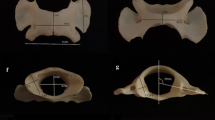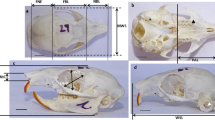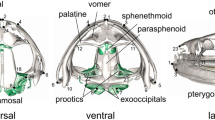Abstract
This study demonstrates sexual dimorphism in feline bones based on morphometric analysis of dried flat bones (scapula and os coxa) and long bones (humerus, radius, ulna, femur, tibia, and fibula) of 92 felines (50 male, 42 female). A total of 58 parameters (flat bones: scapula = 4 and os coxa = 7; long bones: humerus = 8, radius = 9, ulna = 10, femur = 9, tibia = 7, and fibula = 4) were measured using a digital vernier caliper. Twenty-three parameters were found to be significantly different between cats of different sexes and skull shapes. The correlation between the cephalic index and most parameters was negative. Analysis of bone morphometry enabled us to estimate both sex and skull shape with accuracy of up to 96 % and 71 %, respectively, through a stepwise logistic regression model and a stepwise discriminative analysis model. The stepwise logistic regression model was determined to be most suitable for classifying two categories of data and had higher prediction accuracy rate.




Similar content being viewed by others
References
Albanese J (2013) A method for estimating sex using the clavicle, humerus, radius, and ulna. J Forensic Sci 58:1413–1419
Alpak H, Mutus R, Onar V (2004) Correlation analysis of the skull and long bone measurements of the dog. Ann Anat 186:323–330
Balci Y, Yavuz MF, Cağdir S (2005) Predictive accuracy of sexing the mandible by ramus flexure. Homo 55:229–237
Done SH, Goody PC, Evans SA, Stickland NC (2009) Color atlas of veterinary anatomy, vol 3. The Dog and Cat, Elsevier Health Sciences
Duetsch JA, Peterson RD (2012) Using pelvis morphology to identify sex in moose skeletal remains. ALCES 48:1–6
Farhadinia MS, Kaboli M, Karami M, Farahmand H (2014) Patterns of sexual dimorphism in the Persian leopard (Panthera pardus saxicolor) and implications for sex differentiation. Zool Middle East 60:195–207
Franklin D, Cardini A, Flavel A, Marks MK (2014) Morphometric analysis of pelvic sexual dimorphism in a contemporary Western Australian population. Int J Legal Med 128:861–872
Helton WS (2009) Cephalic index and perceived dog trainability. Behav Processes 82:355–358
Hidaka S, Matsumoto M, Hiji H, Ohsako S, Nishinakagawa H (1998) Morphology and morphometry of skulls of raccoon dogs, Nyctereutes procyonoids and badgers, Meles meles. J Vet Med Sci 60:161–167
Jurgelenas E (2015) Osteometric analysis of the pelvic bones and sacrum of the red fox and raccoon dog. Vet Med Zoot 70:42–47
Kauhala K, Viranta S, Kishimoto M, Helle E, Obara I (1998) Skull and tooth morphology of Finnish and Japanese raccoon dogs. Ann Zool Fennici 35:1–16
Kieser JA, Groeneveld HT (1992) Comparative morphology of the mandibulodental complex in wild and domestic canids. J Anat 180:419–424
Kunzel W, Breit S, Oppel M (2003) Morphometric investigations of breed-specific features in feline skulls and considerations on their functional implications. Anat Histol Embryol 32:218–223
McGreevy PD, Georgevsky D, Carrasco J, Valenzuela M, Duffy DL, Serpell JA (2013) Dog behavior co-varies with height, bodyweight and skull shape. PLoS ONE 8:e80529
Monteiro CL, Campos AI, Madeira VL, Silva HV, Freire LM, Pinto JN, de Souza LP, da Silva LD (2013) Pelvic differences between brachycephalic and mesaticephalic cats and indirect pelvimetry assessment. Vet Rec 172:16
Nganvongpanit K, Pitakarnnop T, Buddhachat K, Phatsara M (2016) Gender-related differences in pelvic morphometrics of the retriever dog breed. Anat Histol Embryol 46:51–57
Nganvongpanit K, Buddhachat K, Kaewmong P, Cherdsukjai P, Kittiwatanawong K (2017) What the skull and scapular morphology of the dugong (Dugong dugon) can tell us: sex, habitat and body length? Sci Rep 7:1964
Onar V (1999) A morphometric study on the skull of the German shepherd dog (Alsatian). Anat Histol Embryol 28:253–256
Parés-Casanova PM, Martínez S (2013) Geometric morphometrics for the study of hemicoxae sexual dimorphism in a local domestic equine breed. J Morphol 31:623–628
Phatsara M, Mahakkanukrauh P, Nganvongpanit K (2016) Comparative morphometric study for distinguishing between human and non-human mammalian long bones. Chiang Mai Vet J 14:23–38
Pitakarnnop T, Buddhachat K, Euppayo T, Kriangwanich W, Nganvongpanit K (2017) Feline (Felis catus) skull and pelvic morphology and morphometry: gender-related difference? Anat Histol Embryol 46:294–303
Pohar M, Blas M, Turk S (2004) Comparison of logistic regression and linear discriminant analysis: a simulation study. Metodološki zvezki 1:143
Saber A, Caceci T, Gummow B, Johns K (2016) Morphometric studies on the skull of the Australian domestic cat (F. catus) and its clinical implications for regional anesthesia. J Vet Anat 9:1–24
Sakamoto M, Ruta M (2012) Convergence and divergence in the evolution of cat skulls: temporal and spatial patterns of morphological diversity. PLoS ONE 7:e39752
Saulsman B, Oxnard CE, Franklin D (2010) Long bone morphometrics for human from non-human discrimination. Forensic Sci Int 202:e1–5
Schnitzler CM, Mesquita JM (2006) Cortical bone histomorphometry of the iliac crest in normal black and white South African adults. Calcif Tissue Int 79:373–382
Schnitzler CM, Pettifor JM, Mesquita JM, Bird MD, Schnaid E, Smyth AE (1990) Histomorphometry of iliac crest bone in 346 normal black and white South African adults. Bone Miner 10:183–199
Schoenebeck JJ, Ostrander EA (2013) The genetics of canine skull shape variation. Genetics 193:317–325
Thrall DE, Robertson ID (2015) Atlas of normal radiographic anatomy and anatomic variants in the dog and cat. Elsevier Health Sciences, London
Acknowledgements
The authors are grateful for research funding from Chiang Mai University through the research administration office, providing a budget for our Excellence Center in Veterinary Bioscience and Excellence Center in Osteology Research and Training Center, Chiang Mai University, Chiang Mai, Thailand.
Author information
Authors and Affiliations
Contributions
K.N. designed and conducted all the experiments. T.P. assisted in the experiments and measured bone samples. K.B., P.C., and B.B. assisted in statistical analysis. K.N., K.B., and B.B. assisted in discussions and writing of the manuscript. All authors have read and approved the manuscript for publication.
Corresponding author
Ethics declarations
Conflict of interest
The authors declare that they have no conflict of interest regarding the publication of this paper.
Ethical approval
This experiment was performed on dry bones from the collection of the Anatomy Museum, Faculty of Veterinary Medicine, Chiang Mai University. No ethical approval was required for this study.
Additional information
Publisher's Note
Springer Nature remains neutral with regard to jurisdictional claims in published maps and institutional affiliations.
Rights and permissions
About this article
Cite this article
Boonsri, B., Pitakarnnop, T., Buddhachat, K. et al. Can feline (Felis catus) flat and long bone morphometry predict sex or skull shape?. Anat Sci Int 94, 245–256 (2019). https://doi.org/10.1007/s12565-019-00480-8
Received:
Accepted:
Published:
Issue Date:
DOI: https://doi.org/10.1007/s12565-019-00480-8




